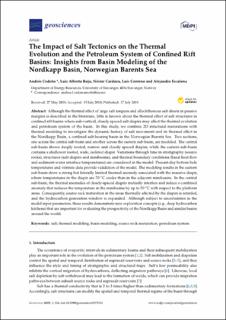| dc.contributor.author | Cedeno Motta, Andres Felipe | |
| dc.contributor.author | Rojo Moraleda, Luis Alberto | |
| dc.contributor.author | Cardozo Diaz, Nestor Fernando | |
| dc.contributor.author | Centeno, Luis | |
| dc.contributor.author | Escalona Varela, Alejandro | |
| dc.date.accessioned | 2021-12-09T14:42:45Z | |
| dc.date.available | 2021-12-09T14:42:45Z | |
| dc.date.created | 2019-09-05T11:12:25Z | |
| dc.date.issued | 2019-07 | |
| dc.identifier.citation | Cedeño, A., Rojo, L. A., Cardozo, N., Centeno, L., & Escalona, A. (2019). The Impact of Salt Tectonics on the Thermal Evolution and the Petroleum System of Confined Rift Basins: Insights from Basin Modeling of the Nordkapp Basin, Norwegian Barents Sea. Geosciences, 9(7), 316. | en_US |
| dc.identifier.issn | 2076-3263 | |
| dc.identifier.uri | https://hdl.handle.net/11250/2833616 | |
| dc.description.abstract | Although the thermal effect of large salt tongues and allochthonous salt sheets in passive margins is described in the literature, little is known about the thermal effect of salt structures in confined rift basins where sub-vertical, closely spaced salt diapirs may affect the thermal evolution and petroleum system of the basin. In this study, we combine 2D structural restorations with thermal modeling to investigate the dynamic history of salt movement and its thermal effect in the Nordkapp Basin, a confined salt-bearing basin in the Norwegian Barents Sea. Two sections, one across the central sub-basin and another across the eastern sub-basin, are modeled. The central sub-basin shows deeply rooted, narrow and closely spaced diapirs, while the eastern sub-basin contains a shallower rooted, wide, isolated diapir. Variations through time in stratigraphy (source rocks), structures (salt diapirs and minibasins), and thermal boundary conditions (basal heat flow and sediment-water interface temperatures) are considered in the model. Present-day bottom hole temperatures and vitrinite data provide validation of the model. The modeling results in the eastern sub-basin show a strong but laterally limited thermal anomaly associated with the massive diapir, where temperatures in the diapir are 70 °C cooler than in the adjacent minibasins. In the central sub-basin, the thermal anomalies of closely-spaced diapirs mutually interfere and induce a combined anomaly that reduces the temperature in the minibasins by up to 50 °C with respect to the platform areas. Consequently, source rock maturation in the areas thermally affected by the diapirs is retarded, and the hydrocarbon generation window is expanded. Although subject to uncertainties in the model input parameters, these results demonstrate new exploration concepts (e.g., deep hydrocarbon kitchens) that are important for evaluating the prospectivity of the Nordkapp Basin and similar basins around the world. | en_US |
| dc.language.iso | eng | en_US |
| dc.publisher | MDPI | en_US |
| dc.rights | Navngivelse 4.0 Internasjonal | * |
| dc.rights.uri | http://creativecommons.org/licenses/by/4.0/deed.no | * |
| dc.subject | petroleumsgeologi | en_US |
| dc.subject | salt | en_US |
| dc.title | The Impact of Salt Tectonics on the Thermal Evolution and the Petroleum System of Confined Rift Basins: Insights from Basin Modeling of the Nordkapp Basin, Norwegian Barents Sea | en_US |
| dc.type | Peer reviewed | en_US |
| dc.type | Journal article | en_US |
| dc.description.version | publishedVersion | en_US |
| dc.rights.holder | © 2019 by the authors | en_US |
| dc.subject.nsi | VDP::Matematikk og Naturvitenskap: 400::Geofag: 450::Petroleumsgeologi og -geofysikk: 464 | en_US |
| dc.subject.nsi | VDP::Teknologi: 500::Berg‑ og petroleumsfag: 510::Geoteknikk: 513 | en_US |
| dc.source.pagenumber | 1-25 | en_US |
| dc.source.volume | 9 | en_US |
| dc.source.journal | Geosciences | en_US |
| dc.source.issue | 7 | en_US |
| dc.identifier.doi | 10.3390/geosciences9070316 | |
| dc.identifier.cristin | 1721835 | |
| dc.source.articlenumber | 316 | en_US |
| cristin.ispublished | true | |
| cristin.fulltext | original | |
| cristin.qualitycode | 1 | |

